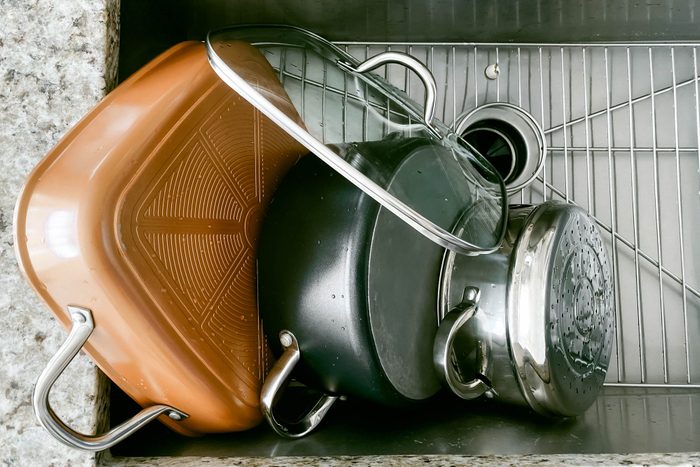
Kitchen safety
Cooking at home is supposed to be so much healthier than ordering out, but there’s one way you could be sabotaging your efforts without even realizing it: by not using the safest cookware. The materials used in certain pots and pans may not be great for you, the environment, or your food. That’s why it pays to know what you’re buying.
Pots or pans with a nonstick coating tend to arouse the most concern. That’s because they are usually made with a polymer coating whose active ingredient is called polytetrafluoroethylene (PTFE), a substance that is more slippery than wet ice, according to the Cookware Manufacturers Association. You may know PTFE by its brand name, Teflon. Studies have found that at temperatures routinely used for cooking (in the range of 400 to 500 degrees Fahrenheit), PTFE releases chemicals that may be unsafe for humans; there is evidence that the same fumes may be deadly to birds, as well. These chemicals also tend to get into our water supply and wreak havoc on the environment because they’re what the FDA calls “forever chemicals.” You may even have some habits that can hasten the wear of your nonstick items, which can ruin your food in addition to causing these other problems.
So, does that mean all nonstick pans are out? And what about your favorite stainless steel and cast iron cookware? We’re going to be honest with you: There’s a lot to think about when deciding on the right items to populate your kitchen. But we’ve made it easy by detailing the pros and cons of each type of cookware below—and highlighting a few great options. Find out which ones will keep your family safe and your food delicious in every cooking scenario.
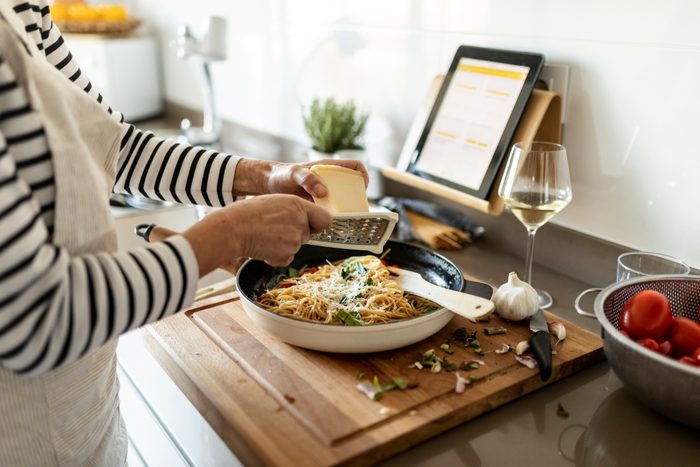
Why is this so important?
Before we dive into the specifics of the best cookware, you should know exactly what you could be dealing with if you choose an unsafe option. Concerns about the impact of these chemicals on human health—including liver and thyroid problems, fertility issues, and even some cancers—led many to be banned from production, but no one is sure whether the replacements, like GenX, are any better. In one study of 14 nonstick cooking pans, the overwhelming majority (79 percent) were coated in PTFE. “In some cases,” researchers wrote, “product claims on the packaging could lead buyers to purchase PTFE-coated pans when they think they’re buying an alternative.” An important note: This type of cookware is just one of the items you use every day that could be toxic.
“It can be hard to decipher marketing jargon,” agrees Palak Patel, a chef at the Institute of Culinary Education. “Something can be nonstick but not nontoxic.” As someone who has used countless pans in her career, she recommends home chefs skip the matched set and instead invest in the pieces and materials that work best for the things they like to cook.
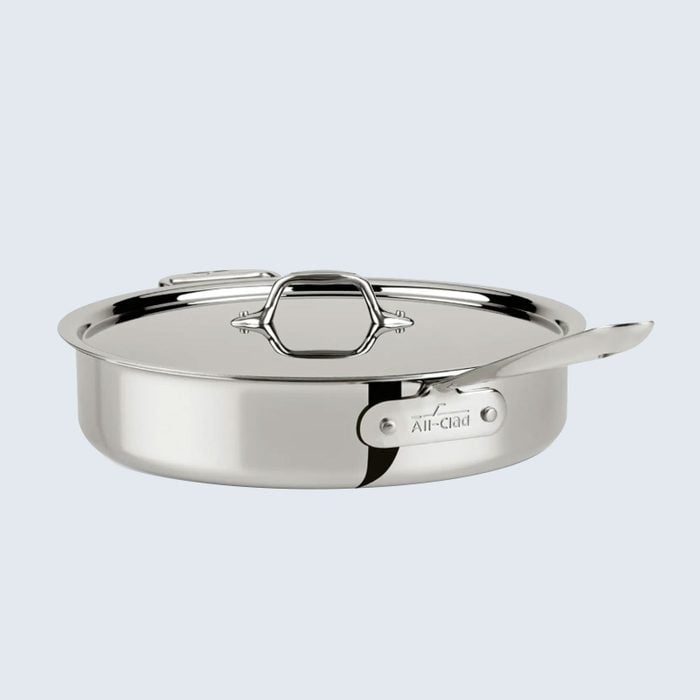 via nordstrom.com
via nordstrom.com
Safest multitasking cookware: Stainless steel
The truth about stainless steel cookware is that it’s really made from a mix of metals. While stainless steel is a durable and nonreactive metal, it’s a poor heat conductor and too heavy on its own. That’s why most stainless pans are what’s known as bonded or clad, says Pamela Stafford, director at Hestan Culinary. They’re comprised of several layers, most often aluminum and stainless, fused together by heat and pressure, and in general, the price goes up with the number of layers. Some manufacturers use alloys that contain nickel for a higher sheen, which can be an issue for people with nickel allergies.
Because of its versatility and durability, stainless steel cookware is the workhorse of a kitchen, but it isn’t nonstick, so you have to use a decent amount of oil or fat. It will also show signs of wear—like scratches and dullness—over time. This 5-quart sauté pan from All-Clad is durable, and you’ll use it all the time. Crafted from three-ply stainless steel, it features straight sides that keep liquids exactly where they’re supposed to be, and it’s also oven- and broiler-safe up to 600 degrees (without the lid). Just make sure not to wash it in cold water when it’s hot or you might ruin it.
Avoid: If you’re trying to cut back on the amount of fat you cook with.
Best for: Just about everything else, even acidic ingredients. (Stainless steel is nonreactive.)
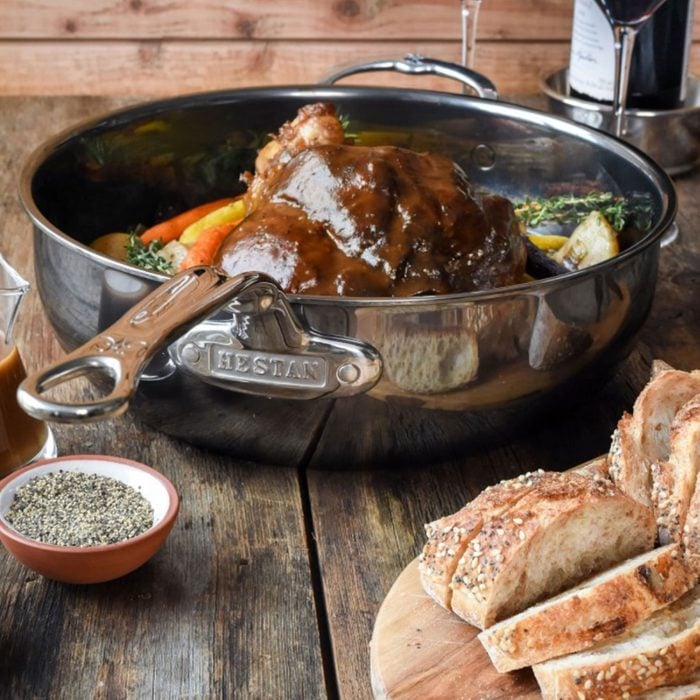 via williams-sonoma.com
via williams-sonoma.com
Safest cookware for fast cooking: Titanium
Titanium cookware sets are fairly pricey, but they’re one of the safer nonstick surfaces available, according to Robert Brown, MD, author of Toxic Home/Conscious Home: A Mindful Approach to Wellness at Home. Hestan’s NanoBond line seals a stainless and aluminum pan, including the rims, with a 100 percent toxin-free chromium and titanium coating to make the surface less porous and more durable. As a result, even pans used in restaurant settings always look like new. Titanium cookware will resist staining, scratching, and salt-pitting.
Avoid: There’s really nothing these pans can’t handle, but they aren’t nonstick, so delicate foods like crepes can be tough for non-professional chefs.
Best for: Anything you want to cook hot and fast, since the pan heats up quickly, and things you need to stir often. To speed things up on busy nights, here are more ways to cook everything faster.
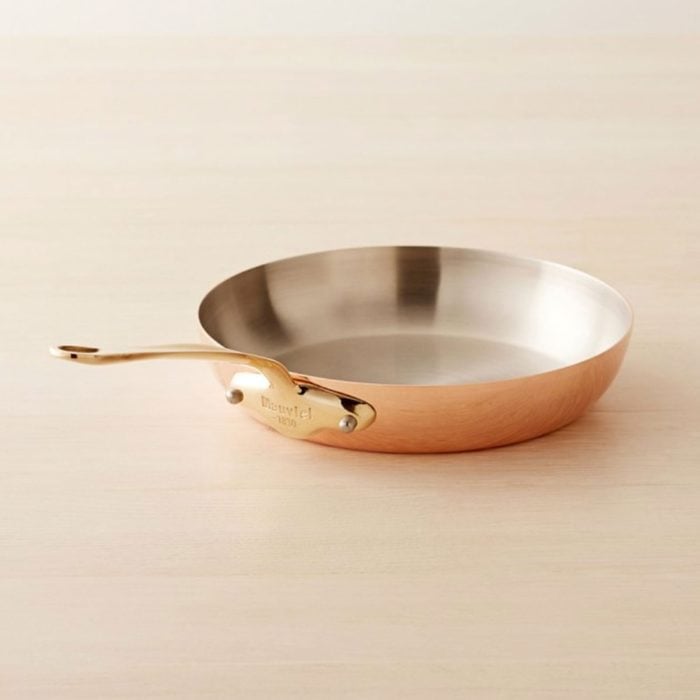 via williams-sonoma.com
via williams-sonoma.com
Safest cookware for delicate sauces: Copper
After aluminum, copper is probably the most conductive metal, and it is prized for its aesthetic appeal and durability. It is also free of harmful chemicals, although it should be avoided by people with Wilson’s disease, a rare inherited disorder that makes it impossible to metabolize copper in the diet, says Rosemary Trout, department head of Drexel University’s Culinary Arts Food Science programs. But the main reason copper hasn’t caught on in cookware is that it can be very expensive. “It’s beautiful but high-maintenance,” says Patel. Most copper cookware is made with other metals, so the copper is just for looks and never actually touches the food inside.
This Mauviel copper fry pan, which is made in France and beloved by professional cooks, is a relatively affordable starter piece. It has a stainless steel interior and low, curved sides so you can more easily flip whatever you’re cooking.
Avoid: Acidic foods like tomato-based sauces or citrus, which can react with copper.
Best for: Copper’s high conductivity makes it ideal for dishes that require fine-tuning the temperature, like chocolate sauces or crème de glacé. Any traditional French dish will work well in copper, and it makes for a jaw-dropping presentation. To up your cooking game even more, check out these 10 cooking tricks that are only taught in culinary schools.
 via fromourplace.com
via fromourplace.com
Safest cookware for breakfast items: Ceramic
A safer alternative to chemical-laden nonstick pans that’s more affordable than titanium, ceramic- or glass-bonded cookware has a naturally nonstick cooking surface so sleek a fried egg will slide right out, no butter needed. Brands like Caraway use a “natural inorganic sand derivative” that does not contain toxic chemicals like PFOA, PFAS, PTFE, lead, or cadmium to produce, and ceramic cookware has no issues withstanding temperatures of up to 650 degrees Fahrenheit. Ceramic-coated cookware is also non-reactive and doesn’t leach chemicals into food, so it’s good for you and the environment and is a great heat conductor.
The Always Pan from Our Place is a cult favorite that’s totally worth it. Not only can it function as a variety of cookware—a fry pan, sauté pan, steamer, skillet, saucier, saucepan, and nonstick pan—but it also boasts pour spouts and comes in seven fun colors. Plus, this 2.6-quart ceramic pan is, of course, non-toxic.
Avoid: Many ceramic coatings aren’t durable enough to withstand very high heat or rough use over time. The ceramic coating will eventually wear away, so save these pans.
Best for: Any kind of eggs, crepes, or pancakes, as well as delicate fish.
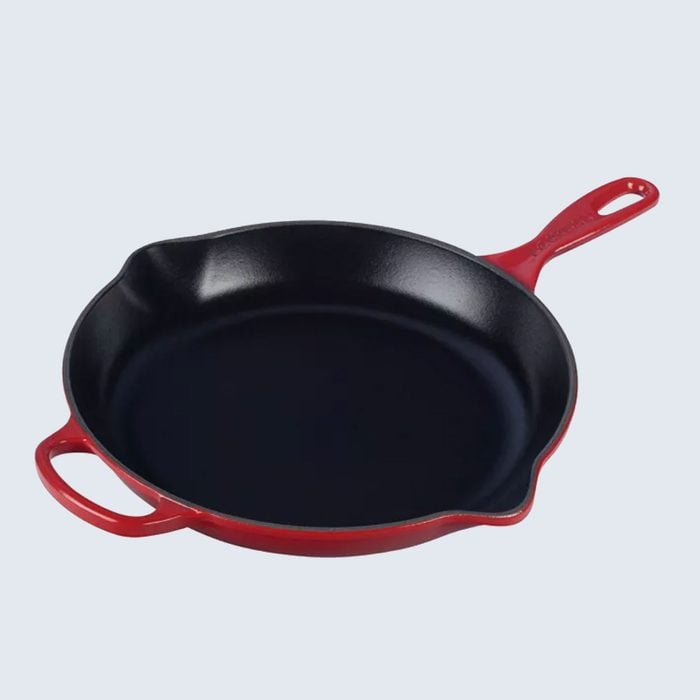 via bloomingdales.com
via bloomingdales.com
Safest cookware for hearty dishes: Cast iron
Cast iron is the gold standard of cookware—and for good reason. Just as the name implies, it’s made by pouring molten iron into a mold, so each pan is a single piece. It’s pretty much indestructible and, when properly cared for, will last lifetimes. (You can find lots of vintage cast iron cookware for this reason.) It also conducts heat exceptionally well, which makes it great for cooking things at higher temperatures, says Patel. Plus, it’s oven-safe, so you can use it on the stove top, in the oven, under a broiler, or even grill with it. It also works with induction cooking and, when seasoned, is naturally nonstick. Research has even found that cooking in cast iron may help fight dietary iron deficiencies.
For many home cooks, however, properly maintaining cast iron can be difficult, Patel says. You can find pre-seasoned or enamel-coated pans, but if you don’t keep your cast iron well oiled and dry, it can rust. And the pans are heavy, which can be difficult for some cooking techniques.
If you’re ready to take the plunge, you can’t go wrong with something from Le Creuset. People are obsessed with this French brand for its reliable cooking results and its gorgeous colors. This 11.75-inch skillet, for example, comes in a rich red, blue, or orange.
Avoid: There are a few foods you should never cook in cast iron, and they include delicate things like thin fillets of fish or crepes.
Best for: “Anything you want to sizzle or char,” says Patel. Think steak, chicken, and pork chops. It’s also ideal for roasting vegetables, deep frying, and even baking things like cornbread.
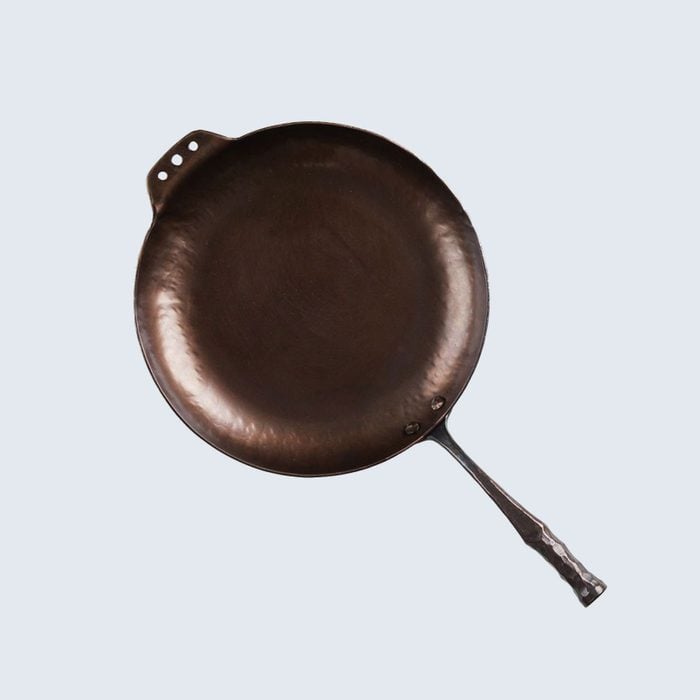 via smithey.com
via smithey.com
Safest cookware for searing: Carbon steel
Carbon steel is the lighter-weight cousin of cast iron, so it has many of the same benefits, like incredible durability and heat retention, but it’s easier to handle, says Will Copenhaver, vice president of marketing and sales for Smithey Ironware. Because of these qualities, many restaurants prefer carbon steel cookware. Like cast iron, it can go in the oven and requires seasoning.
Smithey offers a lightweight carbon steel “farmhouse” skillet inspired by 18th- and 19th-century designs, and it’s actually hand-forged by a blacksmith. And people adore it, raving that it’s “amazing, marvelous, beautiful, and utilitarian” and so gorgeously crafted that it’s “like a piece of art…an instant family heirloom.”
Avoid: Tomato-based dishes, especially if your carbon steel hasn’t been properly seasoned first.
Best for: Because of its ability to hold a steady high heat, it is excellent for foods requiring a good sear, including steaks, burgers, and scallops. Carbon steel is a great material for woks. It can also be great for roasting anything from asparagus to a whole chicken.
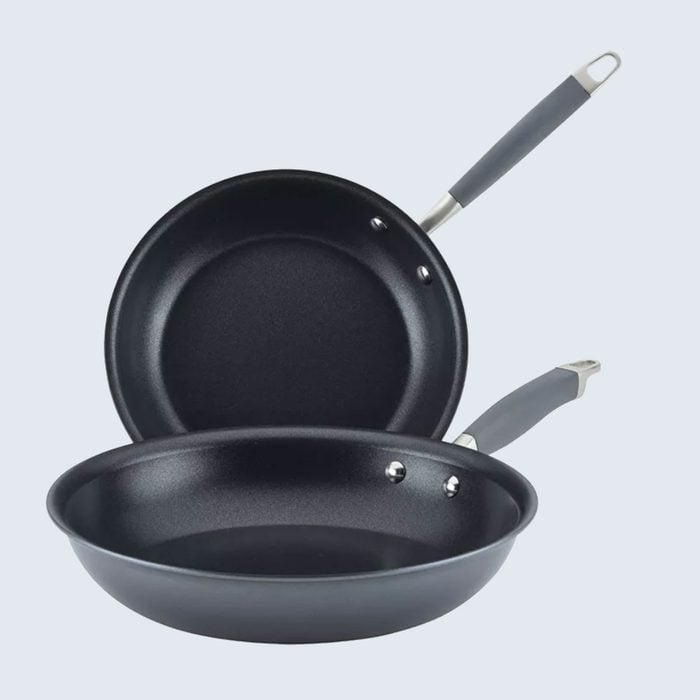 via macys.com
via macys.com
Safest cookware for sautéing: Anodized aluminum
The vast majority of cookware contains at least some aluminum, which is an economical and lightweight metal that conducts heat well. There has been some concern that aluminum may leach into the food you’re cooking, but that has never been linked to any harmful effects, though it can make your food taste off. A better option is anodized aluminum, which Patel calls “a cousin of nonstick.” Anodized aluminum will feel heavier, and it’s been treated to make the metal harder and more durable—although in some cases, that means using PTFE or similar chemicals, so you’ll want to do some extra research before buying.
This set of skillets from Anolon are nonstick but PFOA-free, so you don’t have to worry. And the hard-anodized aluminum is twice as hard as stainless steel, meaning that it’s super durable.
Avoid: Acidic foods, which can react with the metal and subsequently taste bitter. That’s just one of the cooking mistakes that can ruin your food.
Best for: The lightweight material is great for things you have to shake as you cook, such as when sautéing vegetables.
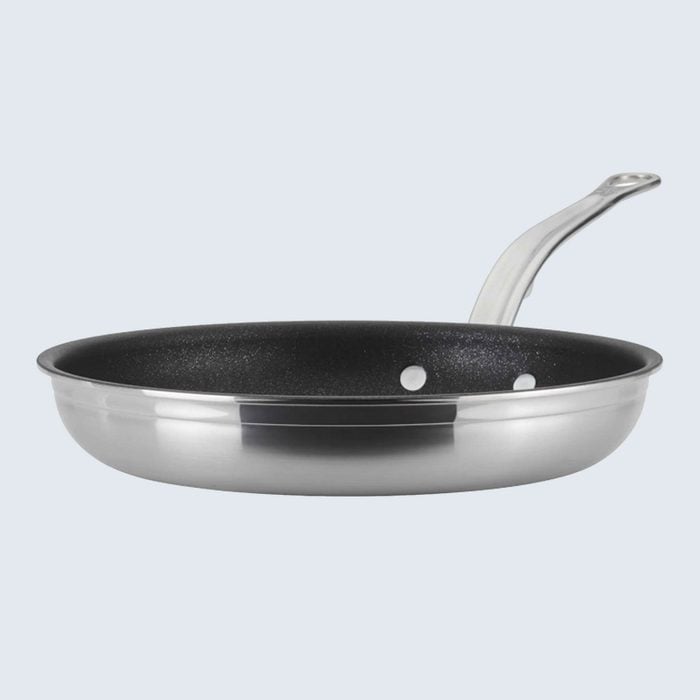 via williams-sonoma.com
via williams-sonoma.com
Safest nonstick cookware: Titum-coated nonstick
There’s no arguing that nonstick pans can be wonderful cooking implements because food slides right out of them and cleanup is a snap. But given the uncertainty surrounding the toxic chemicals used to manufacture various coatings, there are a few precautions you should take. For starters, nonstick is most dangerous when overheated, and that can happen within minutes. One easy way to avoid this is by never preheating an empty nonstick pan. Also, closely monitor the items you own. If your nonstick pan becomes warped or darkly discolored, it’s time to throw it away.
One more important note: Product labels aren’t always clear about what chemicals are in different nonstick surfaces, but you can research brands on your own. Hestan is one manufacturer that uses a toxin-free nonstick surface called Titum. With triple-bonded stainless steel construction, a pure aluminum core, and PFOA-free cooking surface, this fry pan will be your new go-to—and you can feel good about using it.
Avoid: Searing, broiling, or other high heat cooking methods; using metal utensils that can nick or scratch coatings.
Best for: Delicate dishes like frittatas and thin fish fillets; things that could get messy like grilled cheese sandwiches and paninis.
Sources:
- Cookware Manufacturers Association: “Nonstick Coatings”
- Environmental Science and Pollution Research: “PTFE-coated non-stick cookware and toxicity concerns: a perspective”
- Ecology Center: “What’s Cooking? PFAS and Other Chemical Hazards in Nonstick Cooking and Baking Pans”
- Journal of Human Nutrition and Dietetics: “Food prepared in iron cooking pots as an intervention for reducing iron deficiency anaemia in developing countries: a systematic review”
- Treehugger: “What’s the Safest Cookware?”
- The Pipette Pen: “Ask a Toxicologist: Is it safe to use Teflon pans?”
- Healthline: “Is Nonstick Cookware Like Teflon Safe to Use?”
